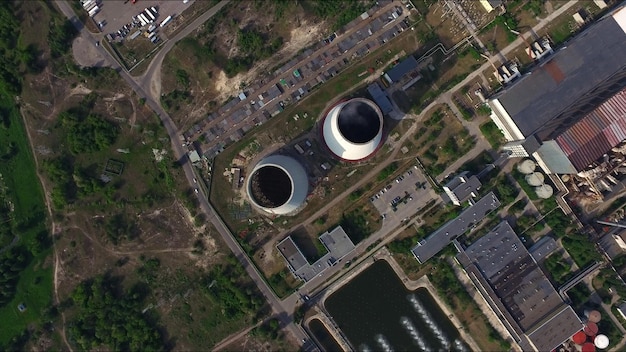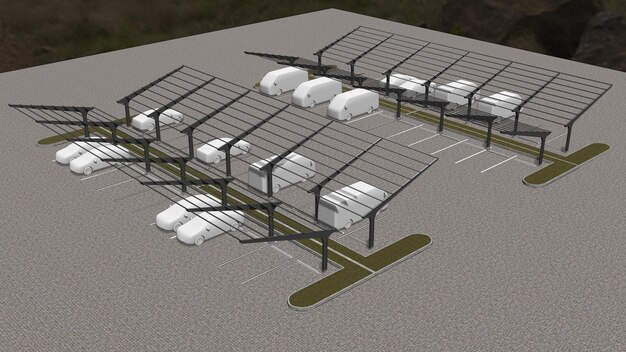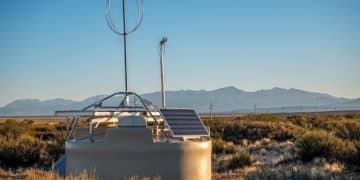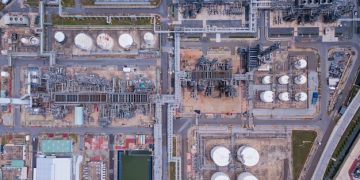US Carbon Capture: Latest Climate Change News & Potential

Climate change news highlights the growing role of US carbon capture technology, seen as vital for reducing emissions and combating global warming, yet its potential hinges on addressing cost and scalability challenges.
Stay informed on the latest climate change news regarding US carbon capture technology and its potential impact on environmental sustainability. Explore the advancements, challenges, and future prospects of this critical technology in the fight against climate change.
Understanding US Carbon Capture Technology
Carbon capture technology in the United States is rapidly evolving, offering a promising approach to mitigate emissions from significant sources. This technology aims to prevent carbon dioxide (CO2) from entering the atmosphere by capturing it at the source and either storing it underground or utilizing it for various industrial applications.
The Process of Carbon Capture
Carbon capture involves several stages, each crucial for the effective removal of CO2 from emission sources. The initial step focuses on separating CO2 from other gases, followed by its compression and transportation to a storage site or utilization facility.
Types of Carbon Capture Technologies
Different technologies are used for carbon capture, including pre-combustion capture, post-combustion capture, and oxy-fuel combustion. Each method varies in its approach, efficiency, and applicability to different emission sources.
- Pre-Combustion Capture: This involves converting fuel into a mixture of hydrogen and CO2 before combustion, making the CO2 capture process more efficient.
- Post-Combustion Capture: This method captures CO2 from the flue gases produced by burning fossil fuels, making it suitable for existing power plants.
- Oxy-Fuel Combustion: This technique burns fuel in pure oxygen, producing a concentrated stream of CO2 that is easier to capture.

Advancements in these technologies are continually improving their efficiency and reducing their costs. Research and development efforts are focused on making carbon capture more economically viable and environmentally sustainable.
US Government Initiatives and Policies
The US government has implemented several initiatives and policies to support the development and deployment of carbon capture technology. These measures aim to accelerate the adoption of carbon capture and contribute to national emission reduction targets.
Funding and Grants
The government provides funding and grants for carbon capture projects, supporting research, development, and demonstration efforts. These financial incentives are critical for advancing the technology and making it more accessible to industries.
Tax Credits and Incentives
Tax credits and incentives are offered to companies that invest in carbon capture projects. These financial benefits help offset the high costs associated with implementing carbon capture technologies.
- 45Q Tax Credit: This provides a tax credit for each ton of CO2 captured and stored or utilized, incentivizing companies to invest in carbon capture projects.
- Bipartisan Infrastructure Law: This law allocates significant funding for carbon capture research, development, and deployment, supporting various projects across the country.
- Inflation Reduction Act: This act includes provisions that enhance the 45Q tax credit, making carbon capture projects more financially attractive.
These policies and initiatives reflect the government’s commitment to addressing climate change and promoting carbon capture as a key solution for reducing emissions.
Carbon Capture Projects in the US
Several carbon capture projects are underway in the United States, showcasing the practical application of these technologies in various industries. These projects demonstrate the potential of carbon capture to reduce emissions and contribute to a cleaner environment.
Industrial Carbon Capture Projects
Many carbon capture projects focus on capturing emissions from industrial facilities, such as power plants, cement factories, and steel mills. These projects aim to reduce the carbon footprint of these industries and pave the way for more sustainable operations.
Direct Air Capture Projects
Direct Air Capture (DAC) projects capture CO2 directly from the atmosphere, offering a unique approach to remove existing CO2. These projects are gaining momentum and are seen as a crucial component of future carbon removal strategies.
Leading companies and organizations are investing in DAC technology, recognizing its potential to address legacy emissions. These projects often involve partnerships with research institutions and government agencies to accelerate their development.

These projects represent significant steps toward deploying carbon capture technologies at scale. They provide valuable insights into the technical, economic, and environmental aspects of carbon capture, informing future projects and policy decisions.
Challenges and Opportunities
Despite its potential, carbon capture technology faces several challenges, including high costs, energy requirements, and the need for suitable storage sites. Addressing these challenges is crucial for realizing the full potential of carbon capture and enabling its widespread adoption.
Cost and Efficiency
The high cost of carbon capture technology is a major barrier to its widespread deployment. Reducing costs and improving efficiency are key priorities for research and development efforts.
Storage Capacity and Infrastructure
Ensuring adequate storage capacity and developing the necessary infrastructure for transporting and storing CO2 are essential for the success of carbon capture projects. Geological formations, such as deep saline aquifers and depleted oil and gas reservoirs, can serve as storage sites.
- Geological Storage: This involves injecting CO2 into underground geological formations for long-term storage, preventing it from entering the atmosphere.
- Infrastructure Needs: Developing pipelines and other infrastructure for transporting CO2 from capture sites to storage locations is crucial for scaling up carbon capture.
- Public Perception: Addressing public concerns about the safety and environmental impacts of CO2 storage is important for gaining support for carbon capture projects.
Overcoming these challenges requires a collaborative effort involving governments, industries, and research institutions. By working together, it is possible to unlock the opportunities presented by carbon capture technology and accelerate its deployment.
Environmental Impact and Sustainability
The environmental impact of carbon capture technology is a critical consideration, as it can significantly affect the sustainability and overall benefits of these projects. Evaluating the life cycle of carbon capture, from energy consumption to potential risks, is vital for ensuring responsible implementation.
Energy Consumption
Carbon capture processes can be energy-intensive, potentially increasing the overall emissions footprint if the energy source is not clean. Utilizing renewable energy sources to power carbon capture facilities can mitigate this impact.
Potential Risks and Mitigation
Potential risks associated with CO2 storage, such as leakage and groundwater contamination, need to be carefully managed. Implementing monitoring and mitigation strategies can minimize these risks and ensure the safety of storage sites.
Sustainable practices are essential for maximizing the environmental benefits of carbon capture. This includes using captured CO2 for beneficial purposes, such as producing valuable products, and minimizing the energy and resource requirements of carbon capture processes.
By addressing these environmental considerations and adopting sustainable practices, carbon capture can play a significant role in reducing emissions and promoting a more sustainable future.
Future Outlook for US Carbon Capture
Looking ahead, the future outlook for carbon capture in the United States is promising, with continued advancements in technology, supportive policies, and increasing investments. These factors are expected to drive the widespread adoption of carbon capture and enhance its role in addressing climate change.
Technological Advancements
Ongoing research and development efforts are focused on improving the efficiency and reducing the cost of carbon capture technologies. Innovations in materials, processes, and system design are expected to make carbon capture more economically viable.
Policy Support and Incentives
Continued government support through policies, funding, and incentives is crucial for driving the deployment of carbon capture. Strengthening the 45Q tax credit and providing additional financial support can incentivize companies to invest in carbon capture projects.
Carbon capture is poised to become an integral part of the US strategy for achieving net-zero emissions. By leveraging technological advancements, policy support, and collaborative partnerships, the United States can harness the full potential of carbon capture to create a cleaner and more sustainable future.
| Key Point | Brief Description |
|---|---|
| 🌱 Carbon Capture | Technology to prevent CO2 from entering the atmosphere. |
| 💰 US Initiatives | Government support through funding, grants, and tax credits. |
| 🏭 Projects in US | Industrial and direct air capture projects reducing emissions. |
| 🌍 Challenges | High costs, energy requirements, and storage needs hinder adoption. |
FAQ
▼
Carbon capture technology involves preventing carbon dioxide (CO2) from entering the atmosphere by capturing it from emission sources and storing it or utilizing it for other purposes.
▼
The main types include pre-combustion capture, post-combustion capture, and oxy-fuel combustion, each suited for different emission sources and offering varied efficiencies.
▼
The US government supports carbon capture through funding, grants, and tax credits, such as the 45Q tax credit, to incentivize companies to invest in these projects.
▼
Challenges include high costs, energy requirements, the need for suitable storage sites, and addressing public concerns about the safety and environmental impacts.
▼
The future looks promising with ongoing technological advancements, supportive policies, and increasing investments driving the widespread adoption of carbon capture as a key climate solution.
Conclusion
As we’ve explored the landscape of carbon capture technology in the United States, it’s clear that this innovation holds significant potential for reducing emissions and combating climate change. However, realizing this potential requires sustained effort, investment, and collaboration across sectors. By addressing the existing challenges and capitalizing on the opportunities ahead, the US can lead the way in deploying carbon capture technologies and creating a more sustainable future.





